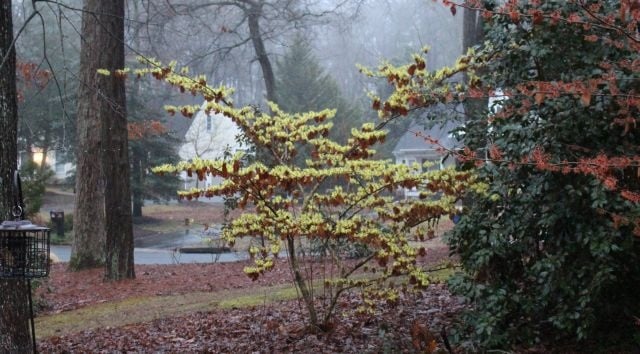Which Witch Hazel?

Nothing is quite as cheery as looking out the window on a dreary, rainy day like today and seeing bright yellow blooms contrasted by the dark brown yet-to-fall leaves from the end of last summer. On this late March morning, not even the early daffodils have opened. Yes, spring is really running late this year and it makes us doubly glad for the witch hazels. The witch hazels on Delmarva have been providing color for a month now and, unless we get a sudden heat wave, they will most likely retain their colorful catkins well into April.
Prunings from witch hazel trees, due to their natural open growth habit, make lovely oriental style arrangements for indoors. Witch hazels are highly desirable shrubs or smallish trees that tend to max out at a height of 12′ – 15′, depending on the species. They are low maintenance, thrive in a variety of locations and are generally disease free. Pruning should only be done to remove suckers (wild growth that shoots straight up, generally from the base of the plant), shape the growth or for bouquets. Witch hazels have been known to have finicky reactions to severe pruning, so it should be avoided whenever possible.
The big question is, “Which witch hazel?”
There are five sub-groups to choose from. You will, of course, want to take into consideration the location, available colors and height at maturity before making your final selection. Once you have decided, you can go to your favorite locally owned nursery and, if they don’t have it in stock (which is likely), they will usually be glad to order it for you. This level of customer service is not often found at the big box stores. Your witch hazel choices include:
• H. x intermedia: these large hybrid shrubs are 10′ – 15′ tall and often grafted. If you purchase in this family, you should remove any suckers that shoot up from the base of the plant every spring and fall. This family of witch hazels comes in a variety of colors that range from bright yellow (Arnold Promise is a good choice), dark coppery orange “Diane” (partially seen on the extreme right side of the photo) and pale yellow (Moonlight). Some have brighter fall foliage than others and, if that is important to you, you will want to verify prior to ordering.
• H. japonica: These are referred to as Japanese Witch Hazels and are of a more upright, tree-like growth habit, sometimes reaching a height of 20′. They tend to produce smaller flowers than H. x intermedia.
• H. vernalis, or Ozark Witch Hazel, is a smaller shrub that is native to the central and southern US, reaching a mature height of 6′-8′.
• H. mollis (Chinese Witch Hazel), tends to be a little bigger than H. vernalis, reaching average heights of 8-10′. It is reported to be an excellent cut flower.
• H. virginiana (common witch hazel) is slow growing with an average height at maturity of 10-15′, sometimes more. Its bark is used in the production of the witch hazel that you find in the pharmacy area of your local stores. H. virginiana’s colorful fall foliage out-performs its smallish flowers.
Get what you want firmly fixed in your mind, then….off your rockers, Gardening Grannies….go out there and find it!
The Gardening Grannies, a mature group of avid and Master Gardeners, live love and garden on the Delmarva Peninsula.


